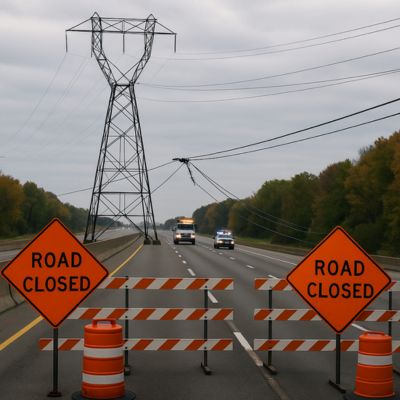I-75 Power Line Shutdown: When Infrastructure Meets Emergency

Interstate 75—stretching from the Canadian border at Michigan to the warm Gulf coast of Florida—is one of America’s most important highways. It connects industrial hubs, suburban commuters, and long-haul truckers in a ceaseless flow of movement. Every hour, thousands of vehicles rely on this massive corridor. But all it takes is one fallen power line to bring that movement to a grinding halt.
The phrase “I-75 power line shutdown” has surfaced repeatedly in recent months, reflecting a troubling pattern of incidents that highlight the intersection of two critical infrastructures: energy and transportation. When power lines fall across a major interstate, it’s not just a traffic issue—it’s a matter of safety, coordination, and resilience.
The Day the Lights Went Down on I-75
On a summer evening in Ohio, traffic along I-75 suddenly came to a standstill. A high-voltage transmission line had collapsed onto the highway after severe thunderstorms swept through the region. Within minutes, law enforcement closed both directions of the interstate, halting cars, trucks, and emergency vehicles alike.
For several tense hours, the once-bustling highway turned into a silent ribbon of flashing lights, hazard markers, and stalled freight haulers. Crews rushed in to cut power to the fallen line, secure the area, and assess damage. By late evening, after multiple inspections, I-75 was cleared and reopened to traffic.
This wasn’t an isolated event. In recent years, storms, aging poles, and wind damage have triggered similar shutdowns in multiple sections of I-75—stretching from Michigan through Ohio and into other parts of the corridor. Each time, the same story unfolds: a storm strikes, power lines fall, the interstate closes, and thousands of travelers and businesses are disrupted.
What Causes These Shutdowns?
Power line incidents on major highways stem from a combination of weather, infrastructure, and design vulnerabilities. While the causes vary, several factors consistently appear:
- Severe Weather: High winds, lightning, and microbursts remain the leading culprits. Strong gusts can snap poles or dislodge lines, sending live cables cascading onto roadways.
- Aging Equipment: Many transmission poles and crossarms along interstate corridors are decades old. Corrosion, material fatigue, or worn insulators make them more susceptible to collapse during storms.
- Tree and Vegetation Encroachment: Trees growing near power easements can fall or shed large branches during wind events, striking wires or poles.
- Soil Saturation and Ground Instability: After heavy rain, saturated soil can loosen pole foundations, causing structural tilt or collapse.
- System Overload: During peak electrical demand or extreme temperature swings, certain grid components face higher stress, increasing the risk of failure.
In essence, each I-75 power line shutdown is not a freak accident but the result of predictable risks converging under extreme conditions.
Why Highways Must Be Closed Entirely
When drivers encounter a closed interstate, frustration often follows. But in the case of a downed power line, full closure is not only prudent—it’s absolutely necessary.
- Electric Hazard: A fallen line can still carry thousands of volts. Even if it appears harmless, residual or back-fed current can energize guardrails, puddles, or vehicles, posing lethal risks.
- Unseen Dangers: Damaged poles, wires hidden in debris, or partial collapses can remain unstable. One small vibration from passing traffic could trigger a further collapse.
- Crew Safety: Utility workers require a controlled zone to isolate and ground the circuit safely. Any moving traffic endangers those efforts.
- Equipment Inspections: After removal, every remaining pole and support system along the affected span must be inspected before reopening.
- Traffic Coordination: Highway patrol and transportation agencies must plan detours, reroute traffic, and ensure emergency access.
The safety protocols are strict because the stakes are life-and-death. Allowing traffic near a live or uncertain electrical environment is simply not an option.
The Chain Reaction of a Shutdown
When I-75 closes—even for a few hours—the effects ripple far beyond the crash cones.
- Traffic Paralysis: The interstate is a freight superhighway. Closing it, even temporarily, creates congestion that spreads across feeder routes and city streets.
- Economic Costs: Each hour of closure represents lost delivery time, fuel consumption from idling trucks, and scheduling disruptions for logistics firms. For commuters and local businesses, it means lost productivity.
- Power Outages: Often, the line that falls is part of a larger grid. That means nearby homes, factories, and offices can also lose electricity, compounding the disruption.
- Emergency Delays: Closed lanes hinder ambulances and first responders who depend on quick access routes.
- Infrastructure Strain: Detours send heavy vehicles onto smaller local roads not designed for sustained truck traffic, accelerating wear and tear.
A single line failure can thus spark a chain reaction through energy, transportation, and economic systems simultaneously.
Inside the Response
Behind every I-75 shutdown lies an orchestrated effort among multiple agencies and crews working under pressure. The response unfolds in several key stages:
1. Immediate Hazard Response
State patrol or local law enforcement first block the area to keep drivers away. Traffic management teams erect barriers, reroute vehicles, and notify control centers.
2. Power Isolation
Utility companies identify which line failed, cut the electrical flow, and verify whether nearby circuits remain energized.
3. Scene Safety and Assessment
Engineers inspect the fallen structure and surrounding poles to determine if the incident was isolated or systemic.
4. Cleanup and Debris Removal
Once power is safely off, crews clear wires, insulators, and pole fragments. Fire services may assist if sparks or smoke occur.
5. Restoration and Reopening
After the scene is cleared and inspected, transportation authorities reopen lanes—often one direction at a time—while utility crews work on permanent repairs.
6. Review and Documentation
Post-incident reports help identify what failed, why it failed, and what preventive actions should follow.
This collaborative choreography, repeated countless times across the country, underscores how intertwined our energy and transportation infrastructures truly are.
The Human Side: Travelers and Crews
For stranded motorists, an I-75 power line shutdown is an unexpected ordeal. Hours can stretch long as updates trickle in. Truck drivers lose delivery windows. Families detour through unfamiliar backroads. Yet for the men and women responding—lineworkers, police, firefighters—the experience is equally intense but from the other side of the barrier.
Working under unpredictable weather, often in the dark, they must approach live lines with utmost caution. Every movement is deliberate, every command verified twice. Their coordination and training are what prevent a dangerous situation from turning tragic.
Lessons in Preparedness
While no system can eliminate risk entirely, there are important steps that governments, companies, and individuals can take to mitigate future shutdowns:
- Modernize Infrastructure: Replacing aging wooden poles with steel or composite materials increases wind resistance and longevity.
- Enhance Monitoring: Smart sensors can detect tension changes or pole lean before a complete failure occurs.
- Vegetation Management: Regular trimming around transmission corridors reduces the likelihood of storm-related contact.
- Buried or Insulated Lines: In critical sections, underground cabling or insulated aerial lines can drastically cut risk.
- Integrated Emergency Planning: Transportation departments and utilities should run joint drills simulating line-down events to refine coordination.
- Public Education: Drivers need clear guidance—stay away from downed lines, respect closure orders, and rely on verified updates instead of speculation.
Each of these measures costs time and money, but the alternative—a shutdown on one of the nation’s busiest highways—is far more costly in the long run.
Environmental and Climate Dimensions
Increasingly, climate change plays a role in these incidents. Stronger windstorms, wetter soils, and more frequent lightning strikes amplify risks. Areas once considered “safe zones” for transmission infrastructure now experience weather extremes that test design limits.
As the Midwest and Great Lakes regions continue to see severe seasonal storms, experts warn that events like the I-75 power line shutdown could become more frequent unless proactive adaptation measures are taken. That includes not only physical reinforcement but smarter forecasting and real-time alert systems integrated across agencies.
A Snapshot of Modern Vulnerability
The I-75 power line shutdown serves as a snapshot of the modern world’s interlocking vulnerabilities. A highway and a power grid, though managed by different entities, depend on one another’s stability. When one falters, both suffer.
The lesson is clear: resilience cannot be siloed. Transportation planning must consider energy reliability, and utilities must account for the physical exposure of their lines along critical transportation routes.
For Drivers: What To Do in a Shutdown
If you’re ever caught near a downed line or highway closure, the following steps can keep you safe:
- Stay in your vehicle unless directed otherwise by authorities.
- Do not touch any metallic parts outside your car, especially if wires are nearby.
- Keep at least 30 feet away from any fallen line.
- Turn around if officials instruct—never cross a barricade.
- Use navigation apps or radio updates to find alternate routes.
- Stay patient; these closures are temporary but vital for safety.
Remember, the danger isn’t visible. Electricity can travel silently through wet ground or metallic surfaces. Treat every downed line as live.
Building the Road Forward
The recent shutdowns along I-75 have sparked conversations among transportation planners, utility companies, and safety experts about how to design a more resilient future.
Potential innovations include modular pole designs that can withstand hurricane-level winds, underground high-capacity conduits in critical intersections, and AI-driven predictive maintenance to flag poles or lines nearing failure. Meanwhile, public-sector agencies are integrating multi-hazard response centers, where weather forecasts automatically trigger inspection alerts for exposed infrastructure.
The overarching goal: reduce the number of shutdowns and shorten recovery times when they do occur.
A Shared Responsibility
Ultimately, the story of the I-75 power line shutdown is not about blame but about balance. America’s infrastructure operates on a delicate harmony between technology, environment, and human management. Each downed line is a reminder that maintenance, investment, and cooperation cannot be postponed.
Drivers rely on safe roads. Communities rely on steady electricity. Businesses rely on predictable logistics. And in the middle stands a network of dedicated professionals ensuring that, even when disaster strikes, recovery is swift.
Closing Thoughts
The I-75 power line shutdown underscores how fragile the intersection of modern energy and transportation systems can be. What seems like a single storm event is in fact a glimpse into a broader challenge: how to safeguard the arteries of commerce and the veins of power that keep society running.
If there’s a lesson to take away, it’s that prevention is collective. From policy makers to lineworkers, from engineers to drivers, everyone plays a role in keeping our infrastructure strong and safe. Each repaired pole and each upgraded sensor is an investment in continuity.
As we move forward, one truth remains steady: safety comes first, but foresight comes a close second.
For more in-depth analysis and real-world stories on transportation and infrastructure resilience, stay tuned to Newsta.



